Fiber development characteristics of cotton mutants: fuzzless-lintless, ligon lintless and fuzzless-lint
pamuk, mutant, taramalı elektron mikroskopi, bitki püskülü, lif, lif özellikleri
Pamuk lif mutantlarının gelişim özellikleri: lintersiz-lintsiz, ligon lintsiz ve lintersiz-lint
cotton, mutants, scanning electron microscopy, lint, fibre, fibre properties,
___
- Anonymous, 1994. Annual report. Raleigh, NC: Cotton Incorporated.
- Applequist, W. L., Cronn R, Wendel J. F. 2001. Comparative development of fiber in wild and cultivated cotton. Evol Dev 3:3-17.
- Basra, A. S., and. Malik, C. P. 1984. Development of the cotton fiber. Int Rev Cytol. 89 :65-112.
- Basra, A. S., and S. Saha. 1999. Growth regulation of cotton fibers. In Cotton Fibers ed. Basra, A. S. Food Products Press, Binghamton, NY.
- Karaca, M, Saha S, Jenkins J.N., Zipf, A., Kohel R, Stelly D. M. 2002 Simple sequence repeat (SSR) markers linked to the Ligon Lintless (Li,) mutant in cotton. J Hered 93: 221-224
- Ji, S. J., Lu, Y.C., Feng, J.X., Wei, G., Li, J., Shi, Y. H., Fu, Q, Liu, D, Luo, J.C., Zhu, Y. X., 2003. Isolation and analyses of genes preferentially expressed during early cotton fiber development by subtractive PCR and cDNA array. Nucleic Acids Res 31: 2534-2543
- Kim, H. J., Triplett, B. A. 2001. Cotton fiber growth in planta and in vitro: models for plant cell elongation and cell wall biogenesis. Plant Physiol 127: 1361-1366
- Kohel, R. J. 1972a. Linkage tests in upland cotton, Gossypium hirsutum L. II. Crop Sci. 12:66-69.
- Kohel, R. J. 1972b. Linkage tests in upland cotton. III. Crop Sci. 18:844-847.
- Orford, S. J., Timmis, J. N. 1998. Specific expression of an expansin gene during elongation of cotton fibers. Biochim Biophys Acta 1398: 342-346.
- Paterson, A.H., Saranga, Y., Menz, M., Jiang, C. X., Wright, R. J. 2003. QTL analysis of genotype-environment interactions effecting cotton fiber quality. Theor Appl Genet 106: 384-396.
- Saha, S., Karaca, M., Jenkins, J.N., Zipf, A.E., Reddy, O.U.K., Pepper, A.E. and Kantety, R. 2003. Simple sequence repeats as useful resources to study transcribed genes of cotton. Euphytica, 130,355-364.
- Sakhanokho, H. F., Zipf, A., Rajasekaran, K., Saha, S., Sharma G.C., and Chee, P.W. 2004. Somatic embryo initiation and germination in diploid cotton (Gossypium arboreum L.) In Vitro Cell. Dev. Biol.-Plant 40:177-181.
- Yu, X. H., Zhu, Y. Q., Lu, S., Zhang, T.Z., Chen, X. Y., Xu, Z. H. 2000. A comparative analysis of a fuzzless-lintless mutant of Gossypium hirsutum L. cv. Xu-142. Sci China Ser C 43: 623-630.
- Zhang, T. Z., Pan, J. J. 1991. Genetic analysis of fuzzless-lintless mutant in upland cotton. Jiangsu J AgricSci7: 14-16.
- Zhu, Y-Q., Xu, K-X., Luo, B., Wang, J-W., and Chen X-Y. 2003. An ATP-binding cassette transporter GhWBCl from elongating cotton fibers. Plant Physiology, 133:580-588.
- ISSN: 1301-2215
- Yayın Aralığı: 2
- Başlangıç: 1983
- Yayıncı: Akdeniz Üniv. Ziraat Fak.
A novel broad spectrum resistance gene (RPW8) controls powdery mildews
Sadık ÇAKMAKÇI, BİLAL AYDINOĞLU, MEHMET ARSLAN, YAŞAR ÖZYİĞİT, Mehmet TETİK, MEHMET BİLGEN
M. Mustafa ERTÜRK, Serkan ÇELİK
Changes in diameters of sweet cherry fruits during ripening process
Waldemar TREDER, Krzysztof KLAMKOWSKI, Pawel WOJCIK
Kurutmalık kırmızı biberlerde androgenesis yoluyla in vitro haploid embriyo uyartımı
Gülat ÇAĞLAR, Veysel ARAS, Arife BAYRAM
HALİL İBRAHİM YOLCU, M. Ziya FIRAT, KEMAL KARABAĞ, MURAT SONER BALCIOĞLU
